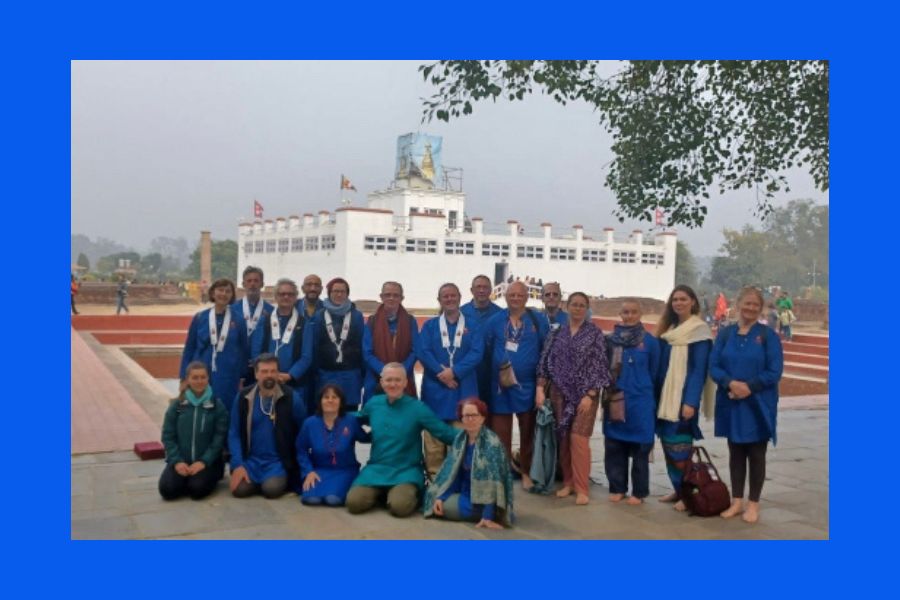Along with 20 other members of the Ipswich Sangha, I am in India. We have been in India for just over two weeks. During that time we have seen many things that have shocked us, that have made us laugh and also cry. We have meditated, chanted and practised in places that have seen Buddhist practise for thousands of years. Each day has brought us new experiences. We have learned to eat with our hands while trying different foods and local specialities. We have met the Triratna India sanghas in the cities we have visited. We have learned about the harsh realities of the caste system, and the effect on peoples lives. We learned of the important part that Dr Ambedkar played in the social enhancement of millions of peoples lives from the 1950‘s to the present day. We have visited Triratna hostels for young disadvantaged children and work training initiatives that bring hope to thousands.
Now we are into the middle section of the pilgrimage, walking in the footsteps of the Buddha. For this section we are joined by six more pilgrims bringing us up to our full compliment of 21.
We have been to Shravasthi, famous for the Jetta Grove in which the Buddha spent 25 yearly rainy season retreats, giving many lectures and talks which you can find captured in the Pali Suttas. In Shravasthi the Buddha also ordained the first person from the lower castes. A so called, untouchable, named Sunita, who was brought into his order against much opposition. Showing that Buddhism is open to all regardless of caste, status or race.
We visited the Buddhist complex at Sanchi, the site of a wonderfully preserved Stupa that houses a portion of the Buddha’s relics. The original Stupa was erected within a few years of the Buddha’s death. But the Stupa we see today was constructed by king Asoka in the 2nd century BCE, it has beautifully detailed carvings that have survived in very good condition for two thousand years!
It is easy when visiting these sites to get carried away by the details; the history, how it was constructed and what some experts think the symbols mean. But ultimately these are places of worship. Places that have maintained the Buddhist faith so that we can become Buddhists in this day and age. India is a noisy place that can easily distract one from the true purpose of a place. Noises that can distract you from true pilgrimage, and make you drop your lofty ideals of being a pilgrim and become just another tourist. Around the great Stupa at Sanchi we circumambulated the Buddha’s relics. We are so close to the Buddha, a strong feeling that gives us a deep sense of reverence and spiritual worth that cannot be reached by mere academic knowledge. We chanted the Shayamuni mantra, as we have done many times back in Ipswich. But this time we where physically close to Shakyamuni, and it makes such a difference.
The inner meaning of the mantra played through my mind as we circumambulated the Stupa chanting, “Om Muni Muni Mahamuni, Shakyamuni Svaha”. Muni is normally translated as ’sage’ but also has the meaning of silence, the quality of a sage. The mantra gives us a teaching about the four levels of silence.
The first level is the external silence, freedom from the noise. Noise from our own lips and from the mouths of others. How many times do we feel the need to break the silence, to resort to distraction, because silence seems to take too much courage to bear. Those around us also try to draw us away from our natural silence. They engage us in conversation, they tell us facts and figures that in reality tell us nothing about the real world. Like a tour guide eager to tell you some theory of the meaning of what is able to be plainly seen by those who have Vision.
So the first level of silence is just to be silent, stand, walk, lie down or sit in silence, so that you can begin to feel in-tune with the harmonies that vibrate through all things. There is a freedom from seeking the distraction of music, in all its forms, from conversations that just distract us from the existential dukkha which is always present in our experience.
When you can do that it is time to move to the next level. The second level is inner silence. Stilling the chatter of our minds. The constant flow of ideas, sub-vocal that distract us from going further into silence. This is the world of the hinderances, which we come upon in our meditations. The silence of meditation, that deepens as we move further into the Dhyanas. As we move way beyond words to just pure thought and even that eventually stills, and the mind becomes like a large lake that is without a ripple, perfectly still so that it reflects like a mirror.
The mantra contains two more levels of silence, which follow a progressive path, going ever deeper. But I will have to leave those to another occasion.
But as most of you, the Ipswich Sangha, are not in India, and I know that a number of you had hoped to join the pilgrimage but unfortunately where not able to do so. There is still plenty you can avail yourself with. Such as following the pilgrims on Polarsteps and all that is happening at the Ipswich Buddhist Centre this month. Do come along and support those who are giving their time and energy for free to make the Dharma available to you.
Bodhivamsa

